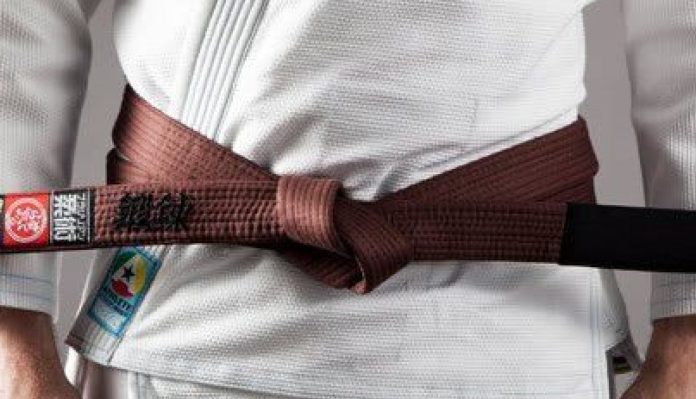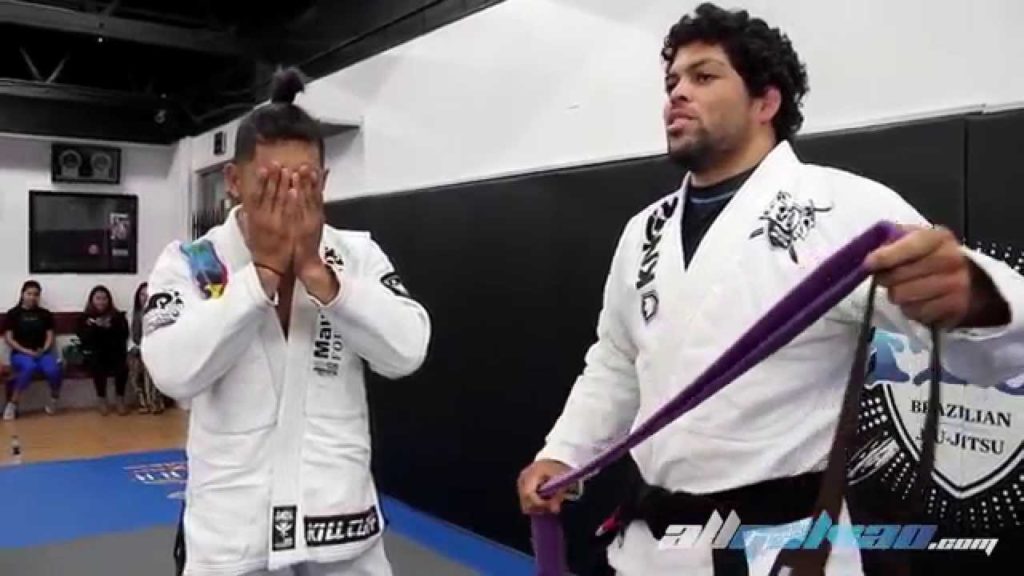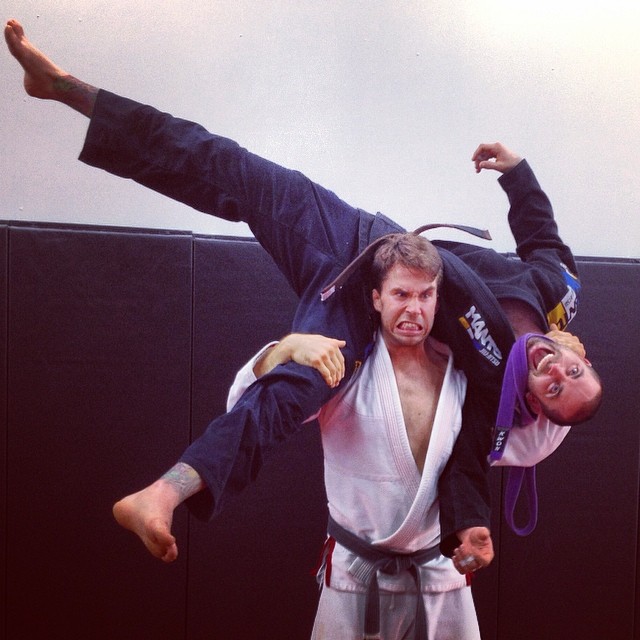
Enjoying your life as a purple belt? Well, you should, as it is probably the most exciting period in BJJ, and it’s belt system. At least it was for me. However, as fun as the purple belt is, it is not really the one we’re after, is it? Brown belt is the belt where everything in BJJ actually happened because that is when Jiu-Jitsu finally starts to make sense. It also happens to be the step just before the grand finale, at least belt-wise – the black belt. But how do you get a brown belt in Jiu-Jitsu? Check out the detailed Jiu-Jitsu Belt Requirements for a Brown Belt!
BJJ Brown Belt Requirements are quite tricky. As a purple belt, you’ve reached the phase of Jiu-Jitsu where everything is open for experimentation. You’re pretty much a teenager in grappling terms at this point. That means that techniques are not as cut and dry as with previous belt requirements. Things blend in together at the purple belt as combinations, chains, and loops, before they finally start making sense at brown. That said, there are big things that you need to achieve at purple before you’re ready to claim that brown belt.
BJJ Brown Belt – This Jiu-Jitsu Thing Starts To Make Sense
At brown belt, Brazilian Jiu-jitsu will finally start to make sense. According to the IBJJF, you need to be at least 18 years of age to be considered for a brown belt promotion. You should also have at least 5-6 years of BJJ experience, with a couple of those spent as a purple belt. In most cases, people get brown after 7-8 years of training, which is pretty much as long as you need to start figuring out that Jiu-Jitsu can make sense, and that there are common niches in everything you do.
BJJ brown belt requirements have more to do with your mindset, your behavior, and your grasp of BJJ as an art, than they do with hit techniques, positions, or movements. Of course, that doesn’t mean that you can go without techniques. It does mean, that you’ll need to look into concepts and start asking questions about the techniques you know. After all, the purple belt is the time when people experiment the most, figuring yot both their standing top and bottom games and moving around like wildcats on a hunt.

BJJ Brown Belt Requirements – An Overview
So, what do BJJ brown belt requirements and the curriculum look like? Well, I certainly can’t talk about the curriculum for everyone, since most schools tend to have their own. However, there are certain things that a brown belt should, or better said, must know.
In terms of the top and bottom game, the mark of a brown belt is balance. If purple belts start off mostly as guard players, when it comes to brown belts, balance is required. That means that in addition to a crazy complex guard game typical of purple belts, BJJ brown belt requirements also contain a number of top game aspects that a grappler has to understand.
In addition to that, submitting people is no longer optional. Purple belts are not really huge on the positional play anyway, unless it is a guard. Usually, purple belts have no problem submitting almost everyone in the gym, bare brown and black belts. The submission mindset is something that they should develop as purple belts because it will be crucial to what lies ahead at brown belt.
There is also the subject of escapes, and while they’re really something that a brown belt must master in order to progress toa black belt, purple is when you should start looking into different ways of escaping and defending. More on that in the detailed BJJ brown belt requirements later.
Detailed Breakdown Of BJJ Brown Belt Requirements
A brown belt needs to understand BJJ. that what that belt is all about. That means that as a purple belt, you should already be heading in that direction. BJJ Brwon belt requirements include a lot of things that are not connected to the technical aspect of Jiu-Jitsu. concepts and principles come to the forefront, with a focus on how to connect things together into a system and then connect different systems together to build a game that reflects your individual character.
As a brown belt, you’ll only refine your personal game while re-learning some of the fundamentals of Jiu-Jitsu, this time completely understanding certain aspects of them. In that sense, movement, top, and bottom games, self-defense aspects, the mindset and the tasks you will have as a brown belt all play a huge role in when you manage to change levels from purple to brown.
1. Movement
A purple belt is as close to a hummingbird as a Jiu-Jitsu player gets. they’re all over the place, spinning, jumping, flying, and inverting, trying to attack submissions most of the time. That is to be expected, as most of the experimentation in BJJ happens during this period. The thing with a brown belt is that, when you finally finish with experimenting, you end up figuring out which few moves work in your favor.

As a brown belt, the task is going to be to understand movement, how and why it works, and simplify everything as much as possible. Although this may sound like the complete opposite of what a purple belt si doing. After you’re done with all the crazy movement-based rolls, you’ll see that there’ is a reason why “lazy BJJ” is such an efficient way of grappling.
2. Bottom Game
PLaying from the bottom in Jiu-Jitsu as a purple belt means you have a crazy amount of guards in your head. However, it is one thing to have a bunch of guard variations in your toolbox, and another to use them to progress your game so that you can select what really fits you, and fulfill the BJJ brown belt requirements.
It is hugely important that you understand the hierarchy of guard layers. Figuring out the distance from the guard, and which guard to use when distance changes is a mark of someone ready to test the brown belt waters. Also, there’s no single move from any guard, but rather intricate combinations and loops of attacks. Closed guard variations will need to reflect that, as will open guards.
-
Closed Guard
The closed guard of the brown belt is sickeningly simple, yet next to impossible to deal with. Brown let’s know how to prevent you from moving, how to utilize the most effective yet ultra-simple grips, and how to submit you without you ever seeing it coming. BJJ brown belt requirements, though, refer to what you learn as a purple belt, and in terms of the closed guard, that is all about lapel guards like the Brabo and pocket guard, and other key concepts, along with crazier stuff like the Octopus guard.
- Brabo Guard [Read More]
- Pocket Guard [Read More]
- Octopus Guard [Read More]
- Concepts [Read More]
-
Closed Guard Attacks
Attacking from the closed guard should reflect control and dominance from this staple BJJ position. As a purple belt looking to become brown, you’ll need to gauge your success with moves against brown and perhaps black belts, rather than lower belts. Submission chains go along way to help you ensure lots of taps. using highly attacking closed guard alternatives like the rat guard is also helpful. Moreover, quick attacks in the form of both sweeps and submissions are also tools you’ll need to develop as a purple belt.
- Reverse Muscle sweep [Read More]
- Submission chains [Read More]
- Rat guard Attacks [Read More]
- Quick Surprise Attacks [Read More]
-
Open Guards
There’s hardly anything I can do to point purple belts to guards – they already have tried them all. However, BJJ brown belt requirements have more to do with understanding how all open guards work as opposed to just collecting different variations of them. That said, some key guard positions like the shin-to-shin, single leg X-guard, worm guard, and all assorted lapel guards, etc are all learned at purple belt level. Moreover, they’re the foundation of understanding guards which is in turn, essential for a brown belt.
- Shin On Shin Guard – [Read More]
- Lasso Guard [Read More]
- Worm Guard [Read More]
- Lapel Guards [Read More]
- Combining Guards [Read More]
-
Open Guard Attacks
If there is one aspect of a purple belt’s game that demonstrates how well they can blend attacks together it is the open guard. The butterfly guard is, of course, the dome of attacks for purple and brown belts, especially when it comes to leg locks and front headlocks. Different guard variations offer different entries into submission and you should know how to connect it all together with minimum movement as part of the BJJ brown belt requirements. The collar guard is a great example.
- Butterfly Guard Attacks [Read More]
- Stretch Guard Submissions [Read More]
- X-Guard Attacks [Read More]
- Collar Guard [Read More]
-
Half Guard
Form the half guard, things get a lot more fun at purple and brown belt level. Most purple belts seem to be fascinated by the deep half gaur, and i think purple belt si a great time to experiment with it. Something else that is highly underrated and ai thinks all brown belts should now is the lockdown half guard, and all its variations and attacking options.
3. Top Game
From the top, BJJ brown belt requirements go well past just controlling positions and passing. IN fac,t submissions while passing or from the top, as well as slick transitions are what marks a purple belt’s readiness to reach the next level. Apart from having options fro mall major positions like side control, mount, knee on belly, back, and turtle, a brown belt will need to transition seamlessly in between them. That just means you really need to study how to dominate them as a purple belt.
-
Side Control
From side control, the task is to tap as many people out as possible. When submissions don’t work, they’ll open up transitioning options (which often just provide more submissions as well) into other positions higher on the hierarchy. Pressure and weight management are among the key BJJ brown belt requirements, and creating variations of side control allows you to figure them out quickly. The crucifix side control is a great example.
- Crucifix Side Control [Read More]
- Submissions from Side Control [Read More]
- “Crazy” Side Control Attacks [Read More]
The Mount
From the mount, a brown belt is practically immovable. The reason for that is that a sap purple belt, they’ve learned different variations to the usual ones people use, and have incorporated them into the mount game. In other words, the low, high and S-mount now get a company in the form of the middle, monkey mount, and the gift wrap. Essentials for anyone looking to progress toa brown belt.
Back Control
The back is another thing that a purple belt excels at. There’s no better human backpack that is trying to strangle you than a purple belt. the only difference with a brown belt si that you can’t shake ab Brown belt of, and they won’t just try, but they’ll strangle you for sure, even when you see it coming. Combining different back attacks is what a purple belt should focus on, as well as some unusual back-related positions, like the twister and truck.
If you’ve ever had a brown belt hold you with a knee on belly you know they can feel like a brick house on top of you, and still move like they’re a feather in the wind. BJJ brown belt requirements for this position include learning how to dominate every angel of the position, as well as moving the knee from the belly not other body parts for better control. Like the neck, for example.
Breaking down the turtle should not be an issue for purple belts. While a brown belt will know exactly why the turtle breaks down and the directions to do it in, a purple belt has a myriad of submission options to finish people while they’re turtled up. From Clock chokes to the Truck, this is the time to try them all and figure out your favorite course of action.
In a guard passing sense, purple belts need to try and figure out some of the main principles of passing. Given that most are more focused on guards than passing, there are at least some aspects of passing that they should know as part of the BJJ brown belt requirements. THose start with Lots of guard passing drills to make up for all the time they spend in guard. Also included are passes like the arm trap, cartwheel pass, body lock, and passing the deep half. Furthermore, using submissions to pass is a mark of someone ready for a promotion.
- Guard Pass Drills [Read More]
- Guard Passing Principles [Read More]
- Arm Trap Pass [Read More]
- Submission Passing [Read More]
- Cartwheel Pass [Read More]
- Body Lock Pass [Read More]
- Deep Half Passes [Read More]
4. Standing

- Lapel takedown [Read More]
- Countering Guard Pulls [Read More]
- Low Single Leg Takedown [Read More]
- The Shuck Takedown Entry [Read More]
- Scissor Takedown [Read More]
- Snapdowns [Read More]
- Inside Trip Takedown [Read More]
- Combining Judo And Wrestling Takedowns [Read More]
- Counter Takedowns [Read More]
5. Submissions
The purple belt’s favorite part of the game, along with guard variations are submissions. In fact, give the BJJ brown belt requirements stat that you should be able to submit everyone from both top and bottom, there’s a lot of things to make sure you master as a purple belt. The leg locking positions and the interplay between them is one aspect. Submission chains from common subs like the Omoplatais another. There’s exploring catch-wrestling and other more obscure submissions as well. Also, there’s no better time to start playing with “grown-up” submissions, like heel hooks, muscle slicers, and neck cranks.
The most important thing, though is developing a submission hunting mindset. Even if you don’t decide to use it all the time, you’ll definitely need it as a brown ad definitely a black belt.
- Leg locks from the top [Read More]
- Mau mau Kimura [Read More]
- Omoplata submission chain [Read More]
- Short Choke (from the back) [Read More]
- Inverted Armbar [Read More]
- Submission Hunting Principles [Read More]
- Unusual Grappling Submissions [Read More]
- Biceps Slicer [Read More]
- Kneebar-toe Hold Combo [Read More]
- Submission Counters [Read More]
6. Escapes
AS a brown belt it becomes a lot more about countering stuff than escaping them. DEfnedign comes first, of course, but escapes usually end up with a submission of your own, or at least get a dominant position instead of a natural one. BJJ brown belt requirements will demand that you know who to escape side control, mount, back, knee no belly, and turtle into a dominant position, or use stuff like the title guard and squirrel lock (for example) to submit people directly form “bad spots”.
- Side control bottom (Triangle submissions from bottom, Squirrel lock) [Read More]
- Mount bottom (Alcatraz, sliding hip, Marcelo escape) [Read More]
- Back Control bottom (Bottom hook escapes, counters, weak side escapes)[Read More]
- Turtle bottom (Turtle guard) [Read More]
- Knee on Belly (LEg trap escape, counters) [Read More]
7. Mindset
When it comes to mindset a purple belt should be focused on movement. They should always be thinking about attacking, mostly in transitions and scrambles. staying on the outside of an opponent while launching attacks is also a way of thinking that usually marks a purple / brown belt. there’s also the submission hunting mindset, I talked about earlier, trying to finish a lot more than you’re trying to hold a position down.
In terms of escaping, BJ Jbrown belt requirements are all about becoming comfortable. It is characteristic of a brown belt to be completely loose and relaxed in bad spots, even deep submissions. however, as a purple belt, you should think about counting most bad spots by attacking as you escape. Looking to become comfortable is one of the main BJ Jbrown belt requirements to fulfill.
Finally, there’s rolling with new students and not trying to kill them. Despite that ask of purple belts begin to donate, a part of BJJ brown belt requirements is learning all about “teaching rolls”. That’s when you use rolls to teach people about Jiu-Jitsu, rather than dominate them completely. it makes no sense to dismantle a brand new white belt – it won’t do any good to either of you.
8. Self-Defense
From a self-defense perspective, a purple belt can hold their own, and there’s not really much to learn at this point. BJJ brown belt requirements just mean you’re aware of what works and what is obsolete. as well as when you can use BJJ to control and diffuse a situation, rather than escalate it.
- Practice self-defense correctly (on the ground and standing) [Read More]
- Moves that work (on the ground and standing) [Read More]
- Understanding the role of BJJ in violent encounters [Read More]
9. Drills And Rolling
When it comes to drills, it is difficult to get purple belts to do them. they’re way past doing animal crawl movements and hip escapes but won’t do repetition drills either. A great idea is to start using scenarios that focus on what they need- transitions and submissions. A great example are the 10th planet warmups that can be set up as drills instead of warm-ups.

10. Behavior
This is a big one. Purple belts tend to be the most stubborn bunch of grapplers on the mats. they think they know all and are very rarely patient enough for anything. yet, they’re the next generation of advanced grapplers in a gym, meaning they will lend to take on teaching rolls, very often starting from the brown belt. One of the greatest BJJ brown belt requirements is for a purple belt to be able to teach JIu-jitsu to others.
Moreover, purple belts will catch the eye at tournaments if they’re competitors. As they near the brown belt, they have the responsibility o representing their academy and what it stand for at tournaments. This has nothing to do with winning or losing matches, and everything to do with sportsmanlike conduct and behind humble. representing the academy (competitors)
Helping around the Academy in any way possible, if it is not teaching as another way for purple belts to start giving back to the art of Jiu-Jitsu. Simply put, purple belts need to start taking roles within the academy, which can range from competitor to ambassador, from assistant coach to a person in charge of attendance cards and paperwork.
11. Optional
Once again, competition and doing extra training outside of the gym are optional for any belt, including purple belts .however, by this time, most people opt to compete anyway. Competing as a purple belt is anything but easy, so there are certain things to focus on, especially when it comes to performing within the bounds of BJJ brown belt requirements.
– Competing
IF a blue belt needed a gameplan in order to compete, a pure belt will need to also understand tactics. Knowing all the rules and loopholes, as well as what’s legal and not is key for a purple belt competitor. In terms of reaching the next level, the tactical execution of the gameplan, and ever more so, the ability to adapt to chaos and scrambles and the unpredictable and come out on top is what professors will be looking at much more than wins or loses.
– Conditioning
At this point in time, after training grappling for more than 6-7 years, your body will be showing signs of abuse. As a purple belt, it is important to first get strong, and second, recover completely from any training you do. Conditioning is easy to see t up and should only be in focus several weeks before a tournament. During the other time, simple strength training should be the main thing, along with recovery routines and injury prevention methods.
Conclusion
All in all, BJJ brown belt requirements are different than purple and blue belt ones. At brown belt, the understanding of BJJ matures to a whole different level, and people go very deep into the essence of the sport. That is exactly why the purple belt period is both so fun and so important – it is when you learn most of BJJ from a technical standpoint. Al that experimentation coming together will mean that you are ready to reach the next level and be just one step shy of the coveted black belt in Brazilian Jiu-Jitsu.


![Darce Choke Encyclopedia – Origins, Mechanics and Variations [2025] BJJ, choke, Brabo, BJJ Darce Choke, D'arce Choke, Darce BJJ Choke](https://bjj-world.com/wp-content/uploads/2017/11/JungPoirierLeeYahoo-218x150.jpg)









![DONE! Gordon Ryan Retiring—and Danaher Might Not Be Far Behind! [2025] Gordon Ryan Retiring—and Danaher Might Not Be Far Behind!](https://bjj-world.com/wp-content/uploads/2025/04/LEG-GRABS-3-1-218x150.png)

![6 Most Essential Skills Base Top Dima Murovanni DVD Review [2025] 6 Most Essential Skills Base Top Dima Murovanni DVD Review](https://bjj-world.com/wp-content/uploads/2025/04/essential-skills-base-top-dima-murovanni-dvd-review-218x150.png)

![Cross Ashi Garami Firas Zahabi DVD Review [2025] Cross Ashi Garami Firas Zahabi DVD Review](https://bjj-world.com/wp-content/uploads/2025/04/cross-ashi-garami-firas-zahabi-dvd-review-218x150.png)

![Reverse De La Riva System Mikey Musumeci DVD Review [2024] Reverse De La Riva System Mikey Musumeci DVD Review](https://bjj-world.com/wp-content/uploads/2024/11/reverse-de-la-riva-system-mikey-musumeci-dvd-review-324x235.png)



![Standing Leg Entries Alex West DVD Review [2025] Standing Leg Entries Alex West DVD Review](https://bjj-world.com/wp-content/uploads/2025/03/standing-leg-entries-alex-west-dvd-review-100x70.png)
![Welcome To The Darce Side Travis Moore DVD Review [2025] Welcome To The Darce Side Travis Moore DVD Review](https://bjj-world.com/wp-content/uploads/2025/01/welcome-to-the-darce-side-travis-moore-dvd-review-100x70.png)

![X-Guard Trickery Kyle Sleeman DVD Review [2025] X-Guard Trickery Kyle Sleeman DVD Review](https://bjj-world.com/wp-content/uploads/2025/03/x-guard-trickery-kyle-sleeman-dvd-review-100x70.png)

![Get Off My Legs Gringo Craig Jones DVD Review [2025] Get Off My Legs Gringo Craig Jones DVD Review](https://bjj-world.com/wp-content/uploads/2025/03/get-off-my-legs-gringo-craig-jones-dvd-review-100x70.png)

![Forging The De La Riva Guard Giancarlo Bodoni DVD Review [2025]](https://bjj-world.com/wp-content/uploads/2025/02/de-la-riva-guard-giancarlo-bodoni-dvd-review-100x70.png)
![Miko Hytonen Lapel Chokes From Everywhere DVD Review [2024] Miko Hytonen Lapel Chokes From Everywhere DVD Review](https://bjj-world.com/wp-content/uploads/2024/10/miko-hytonen-lapel-chokes-from-everywhere-dvd-review-100x70.png)
![Kill The Underhook Dima Murovanni DVD Review [2024] Kill The Underhook Dima Murovanni DVD Review](https://bjj-world.com/wp-content/uploads/2024/10/kill-the-underhook-dima-murovanni-dvd-review-100x70.png)



![Compass Kneebar System Charles Harriott DVD Review [2024] Compass Kneebar System Charles Harriott DVD Review](https://bjj-world.com/wp-content/uploads/2024/11/compass-kneebar-system-charles-harriott-dvd-review-100x70.png)
![Tricks for Unstoppable Takedowns Georges St Pierre DVD Review [2024] Tricks for Unstoppable Takedowns Georges St Pierre DVD Review](https://bjj-world.com/wp-content/uploads/2024/12/unstoppable-takedowns-georges-st-pierre-dvd-review-100x70.png)
![Crush The Guard Vagner Rocha DVD Review [2024] Crush The Guard Vagner Rocha DVD Review](https://bjj-world.com/wp-content/uploads/2024/10/crush-the-guard-vagner-rocha-dvd-review-100x70.png)



![Flow Pressure Kauan Barboza DVD Review [2025] Flow Pressure Kauan Barboza DVD Review](https://bjj-world.com/wp-content/uploads/2025/02/flow-pressure-kauan-barboza-dvd-review-100x70.png)





